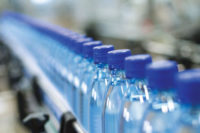When Leprino Foods, Roswell, NM needed to replace its bulky, cast iron/bronze-fitted industrial-grade boiler feed pumps, it considered all options. “Pump conditions for boiler applications include high temperatures, high pressures and the heightened risk of cavitation due to suction head pressure differentials,” says Tim Hutcheson, plant engineering manager.
Pump cavitation is an audible implosion of entrained gases due to suction pressure differences within the pump. Because of reduced space in the boiler room and the resulting increase in downtime and maintenance, Leprino broke from tradition and installed three Wi 70/30-series high efficiency centrifugal pumps from APV Fluid Handling.
Typically, boiler feed or condensate recycling pumps handle condensate with temperatures up to 200° F where the net positive suction head required (NPSHR) is low enough to prevent cavitation. There are actually two values of NPSH: NPSHR (required) and NPSHA (available). NPSHR refers to the minimum suction pressure required to prevent cavitation and is determined by pump design. NPSHA is calculated using pressure, temperature and tank elevation measurements of the specific application. When the “required” value rises above the “available” suction, cavitation results.
This can be corrected either by raising the NPSHA through process parameter manipulation, or reducing the NPSHR through pump design. “Construction in the boiler room reduced overhead space and thereby reduced the NPSHA,” notes Hutcheson. “This led to pump cavitation and increased maintenance and repair requirements on the existing pumps. We needed to install a pump with a much lower NPSHR to compensate.”
APV’s W-series pumps have the patented Universal Inducer, which is an auger-type device located at the eye of the impellers in place of the impeller nut. This helical screw rotates at impeller speed raising the inlet pressure to the pump thereby lowering the NPSHR by 50 to 70 percent.
“Our condensate enters the 40-hp pump at 227° F and about 15.5 psi,” says Hutcheson. “It pulls water from our de-aeration tank and pumps it directly to the boiler for use in making steam for plant operations. We have found no other pump of this size having its capabilities.” Hutcheson reports decreasing downtime dramatically, and very little maintenance. “I think we replaced one mechanical seal during the past two years.”
APV Fluid Handling America, 100 South CP Ave., Lake Mills, WI 53551 Tel: 920-648-8311 Fax: 920-648-1590.
